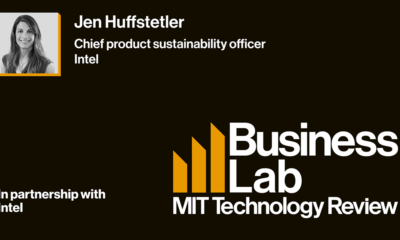Politics
Enterprise Private Wireless: Enabling Secure, Reliable Communications With Edge Computing
Published
2 years agoon
By
Drew Simpson
It’s no secret that digital transformation is top-of-mind across enterprises, but many organizations have neglected to upgrade their connectivity solutions. This isn’t a surprise, as billions have been spent promoting 5G solutions. Still, enterprises have been slow to adopt the technology, in part because of its complicated on-prem infrastructure, which is very expensive to both implement and maintain.
Private wireless solutions that utilize the power of the edge can provide businesses with digital transformation needs. The solutions include secure, reliable connectivity, cutting through the unnecessary complexities of traditional solutions, and reducing reliance on legacy carriers.
What’s more, private wireless solutions are far more cost-effective and quick to implement — especially when deployed using APIs — than those of the major cellular service providers, giving enterprises the flexibility to build and expand their networks as needed.
Enterprise Private Wireless
With significant performance, security, and cost-saving benefits, enterprise private wireless has the ability to make an immense impact on a wide variety of industries such as healthcare, education, smart cities, and even across the supply chain in warehousing and manufacturing.
Read on as I highlight each of these industries’ connectivity-related pain points, as well as the unique value propositions that enterprise private wireless can deliver for key enterprise segments.
Private Wireless in Healthcare
Healthcare facilities grow organically over time, leading to a labyrinth of buildings and campuses that are unfriendly to the unlicensed spectrum provided by traditional Wi-Fi.
Effective communication is the lifeblood of timely and efficient care. As we know, the use cases that the healthcare community relies upon span patient, physician, and even machine-to-machine. This makes dependable network connectivity harder and harder to maintain, especially as more mission-critical use cases and device types get added to already-strained Wi-Fi networks.
Furthermore, a lack of high-performance network connectivity makes it difficult to accurately track patients, personnel, and equipment in emergency situations.
Advancement in Healthcare Tech
Given the advancement in healthcare technology and protocols, hospitals are proving to be early adopters in the emergence of operational technology that brings together a tapestry of users and use cases that drive better outcomes for patients and more efficient delivery for practitioners.
Enhanced Operation Through Sensors and Mobile Devices
Sensors and other mobile devices throughout a facility improve efficiencies and enhance operations, but this class of new simplified endpoints needs access to higher performance connectivity.
The time-sensitive nature of these communications also requires a robust and dependable network to work efficiently. Furthermore, new technology implementations can leave networks more susceptible to breaches if not thoroughly secured, and healthcare facilities are rife with valuable information for potential hackers.
Patient privacy, especially, must be carefully guarded in order to continuously comply with strict HIPAA regulations. Private enterprise cellular solutions can deliver all of the above and more.
Consider Edge-Based Private Cellular Solutions
Edge-based private cellular solutions deliver reliable, secure communications across facilities to improve critical care experiences and ensure regulatory compliance — all while integrating with existing IT network governance.
The edge allows for stronger, more mobile network connections than those provided by traditional Wi-Fi offerings, ensuring equipment and systems spread out across the facility stay online at all times.
Private wireless networks also enhance security measures related to connectivity, helping to keep unauthorized eyes off of patients’ private information even when implementing new technologies.
With private wireless solutions powered by the edge, healthcare providers can administer crucial services and maintain patient privacy without needlessly worrying about the resilience of the enterprise connectivity platform.
Private Wireless in Education
Universities, K-12, and related organizations continue to have difficulty ensuring reliable coverage and network performance across their campuses. With hard-to-reach locations both inside and outside campus buildings, issues stemming from traditional Wi-Fi technology are rampant, as it fails to provide the mobility needed across widespread areas.
Furthermore, on nearly every educational campus, there are places where Radio Frequency (RF) blind spots and interference cut connectivity completely.
Stable Connectivity Ensure Safety
Stable connectivity infrastructure is required to ensure the safety of students and personnel — no matter where they are on the property. With carrier-class private wireless solutions, educational institutions can ensure their security, surveillance, and access control systems are working around the clock to maintain strict safety measures.
Schools can even utilize their networks to send out targeted communications to students, staff, and the community at large, including class notifications, campus weather alerts, schedule changes, and more. Additionally, edge-based solutions enable IT teams, to implement new localized and experimental applications in a much faster, more cost-effective way.
As educational institutions seek to upgrade their networks to keep up with an increasingly digital society, they should also look into what federal grants their organizations may be eligible for when it comes to connectivity.
Multiple federal programs exist today dedicated to providing billions of dollars to get campus communities better connected and help close the digital divide.
Private Wireless in Smart Cities
The more technology has evolved, the more businesses, consumers, and entire communities demand. However, legacy service providers cannot execute and deliver quickly enough to keep up with continued evolution and demand. The 5G ecosystem is too complicated, too hard to program, and too expensive to implement and maintain. This is especially true when it comes to covering entire cities.
“Smart cities” are becoming increasingly common as technology continues to infiltrate more and more of our lives, but much of America’s infrastructure is in need of investment, improvement, and intelligence. As such, the next generation of connectivity and computing implemented at a wide-scale municipal level will need to be used to help support reimagined roads, utilities, public transportation systems, and much more.
Digital Transformation of This Magnitude Should Move to the Edge
Simply put, cities looking to supercharge their digital transformation initiatives need to move to the edge. By implementing edge-based private wireless solutions, smart cities can enable stronger, safer connectivity across their communities. Complexity and costs associated with the implementation and maintenance of traditional mobile networks will be enhanced.
Smart traffic lights, low latency utility monitoring, real-time transit information, and accessible computing resources are just a few examples of the types of public benefits edge-based private wireless can enable.
Ultimately, the edge guarantees fast and reliable low-latency responses for the applications that require them most, creating more secure, more productive municipalities overall.
Private Wireless in the Supply Chain
The global supply chain has been under immense pressure for a while now due to a series of devastating worldwide events, and increasing investment in various supply chain technologies.
For instance, on the manufacturing and warehousing facility floors, humans and robots are working closer than ever as crucial elements of highly complex workflows optimized for the digital world. This means strong, reliable connectivity has never been as important in these spaces as it is today.
By ensuring connections remain firmly intact at all times, private wireless solutions powered by the edge can help ensure the safety of all supply chain personnel and equipment. It will help to drive continuous supply chain productivity. Additionally, cellular-class private network mobility substantially eclipses that of traditional Wi-Fi offerings, also enabling easy portability of the network.
What About Device Security With Private Mobile Networks?
As it pertains to device security — private mobile networks are able to secure all devices on the manufacturing and warehousing floors just as well, or even better, than a traditional cellular network can. Standard enterprise security mechanisms also natively apply, providing unparalleled defense against any would-be hackers.
When supply chain players look to deploy private mobile networks, it’s important for them to do thorough research to land on a solution that provides the maximum benefit for the lowest cost and the quickest deployment time.
A number of existing options require costly, time-consuming equipment and software implementation–but not all. Modern solutions that utilize easy-to-use APIs simplify the implementation and operation of a network, providing manufacturers and warehousers with the secure mobile connectivity they require to keep business running smoothly and safely today and beyond.
Last Words
As described throughout this article, private cellular solutions powered by the edge can greatly boost performance and security across the enterprise in key industries like healthcare, education, smart cities, and warehousing and manufacturing.
Offerings from traditional providers are expensive and often require long lead times plus mounds of equipment to implement.
Private wireless solutions powered by flexible, programmable APIs allow enterprises across industries to host, orchestrate, and customize mobile and Industry 4.0 applications at the Edge–as-a-Service.
This allows enterprises to time investments and enable enterprise connectivity capabilities to meet the diverse needs of use cases and users with a highly secure, reliable, and cost-effective long-term enterprise communications platform.
Featured Image Credit: Conny Schneider; Unsplash; Provided by the Author; Thank you!
Mike Mulica
Alef CEO Mike Mulica has been at the nexus of mobile communications, the internet and globally scaled industry solutions for the past three decades. Mike is a mobile and internet industry veteran, playing a foundational role in pioneering the Mobile Internet, and has led many highly successful companies and product introductions across the globe.
You may like
-


Capitalizing on machine learning with collaborative, structured enterprise tooling teams
-


The Download: are we alone, and private military data for sale
-


The power of green computing
-


Enabling enterprise growth with data intelligence
-


China rolls out plan to boost computing power infrastructure
-


Bolstering enterprise LLMs with machine learning operations foundations
Politics
Fintech Kennek raises $12.5M seed round to digitize lending
Published
7 months agoon
10/11/2023By
Drew Simpson
London-based fintech startup Kennek has raised $12.5 million in seed funding to expand its lending operating system.
According to an Oct. 10 tech.eu report, the round was led by HV Capital and included participation from Dutch Founders Fund, AlbionVC, FFVC, Plug & Play Ventures, and Syndicate One. Kennek offers software-as-a-service tools to help non-bank lenders streamline their operations using open banking, open finance, and payments.
The platform aims to automate time-consuming manual tasks and consolidate fragmented data to simplify lending. Xavier De Pauw, founder of Kennek said:
“Until kennek, lenders had to devote countless hours to menial operational tasks and deal with jumbled and hard-coded data – which makes every other part of lending a headache. As former lenders ourselves, we lived and breathed these frustrations, and built kennek to make them a thing of the past.”
The company said the latest funding round was oversubscribed and closed quickly despite the challenging fundraising environment. The new capital will be used to expand Kennek’s engineering team and strengthen its market position in the UK while exploring expansion into other European markets. Barbod Namini, Partner at lead investor HV Capital, commented on the investment:
“Kennek has developed an ambitious and genuinely unique proposition which we think can be the foundation of the entire alternative lending space. […] It is a complicated market and a solution that brings together all information and stakeholders onto a single platform is highly compelling for both lenders & the ecosystem as a whole.”
The fintech lending space has grown rapidly in recent years, but many lenders still rely on legacy systems and manual processes that limit efficiency and scalability. Kennek aims to leverage open banking and data integration to provide lenders with a more streamlined, automated lending experience.
The seed funding will allow the London-based startup to continue developing its platform and expanding its team to meet demand from non-bank lenders looking to digitize operations. Kennek’s focus on the UK and Europe also comes amid rising adoption of open banking and open finance in the regions.
Featured Image Credit: Photo from Kennek.io; Thank you!
Radek Zielinski
Radek Zielinski is an experienced technology and financial journalist with a passion for cybersecurity and futurology.
Politics
Fortune 500’s race for generative AI breakthroughs
Published
7 months agoon
10/11/2023By
Drew Simpson
As excitement around generative AI grows, Fortune 500 companies, including Goldman Sachs, are carefully examining the possible applications of this technology. A recent survey of U.S. executives indicated that 60% believe generative AI will substantially impact their businesses in the long term. However, they anticipate a one to two-year timeframe before implementing their initial solutions. This optimism stems from the potential of generative AI to revolutionize various aspects of businesses, from enhancing customer experiences to optimizing internal processes. In the short term, companies will likely focus on pilot projects and experimentation, gradually integrating generative AI into their operations as they witness its positive influence on efficiency and profitability.
Goldman Sachs’ Cautious Approach to Implementing Generative AI
In a recent interview, Goldman Sachs CIO Marco Argenti revealed that the firm has not yet implemented any generative AI use cases. Instead, the company focuses on experimentation and setting high standards before adopting the technology. Argenti recognized the desire for outcomes in areas like developer and operational efficiency but emphasized ensuring precision before putting experimental AI use cases into production.
According to Argenti, striking the right balance between driving innovation and maintaining accuracy is crucial for successfully integrating generative AI within the firm. Goldman Sachs intends to continue exploring this emerging technology’s potential benefits and applications while diligently assessing risks to ensure it meets the company’s stringent quality standards.
One possible application for Goldman Sachs is in software development, where the company has observed a 20-40% productivity increase during its trials. The goal is for 1,000 developers to utilize generative AI tools by year’s end. However, Argenti emphasized that a well-defined expectation of return on investment is necessary before fully integrating generative AI into production.
To achieve this, the company plans to implement a systematic and strategic approach to adopting generative AI, ensuring that it complements and enhances the skills of its developers. Additionally, Goldman Sachs intends to evaluate the long-term impact of generative AI on their software development processes and the overall quality of the applications being developed.
Goldman Sachs’ approach to AI implementation goes beyond merely executing models. The firm has created a platform encompassing technical, legal, and compliance assessments to filter out improper content and keep track of all interactions. This comprehensive system ensures seamless integration of artificial intelligence in operations while adhering to regulatory standards and maintaining client confidentiality. Moreover, the platform continuously improves and adapts its algorithms, allowing Goldman Sachs to stay at the forefront of technology and offer its clients the most efficient and secure services.
Featured Image Credit: Photo by Google DeepMind; Pexels; Thank you!
Deanna Ritchie
Managing Editor at ReadWrite
Deanna is the Managing Editor at ReadWrite. Previously she worked as the Editor in Chief for Startup Grind and has over 20+ years of experience in content management and content development.
Politics
UK seizes web3 opportunity simplifying crypto regulations
Published
7 months agoon
10/10/2023By
Drew Simpson
As Web3 companies increasingly consider leaving the United States due to regulatory ambiguity, the United Kingdom must simplify its cryptocurrency regulations to attract these businesses. The conservative think tank Policy Exchange recently released a report detailing ten suggestions for improving Web3 regulation in the country. Among the recommendations are reducing liability for token holders in decentralized autonomous organizations (DAOs) and encouraging the Financial Conduct Authority (FCA) to adopt alternative Know Your Customer (KYC) methodologies, such as digital identities and blockchain analytics tools. These suggestions aim to position the UK as a hub for Web3 innovation and attract blockchain-based businesses looking for a more conducive regulatory environment.
Streamlining Cryptocurrency Regulations for Innovation
To make it easier for emerging Web3 companies to navigate existing legal frameworks and contribute to the UK’s digital economy growth, the government must streamline cryptocurrency regulations and adopt forward-looking approaches. By making the regulatory landscape clear and straightforward, the UK can create an environment that fosters innovation, growth, and competitiveness in the global fintech industry.
The Policy Exchange report also recommends not weakening self-hosted wallets or treating proof-of-stake (PoS) services as financial services. This approach aims to protect the fundamental principles of decentralization and user autonomy while strongly emphasizing security and regulatory compliance. By doing so, the UK can nurture an environment that encourages innovation and the continued growth of blockchain technology.
Despite recent strict measures by UK authorities, such as His Majesty’s Treasury and the FCA, toward the digital assets sector, the proposed changes in the Policy Exchange report strive to make the UK a more attractive location for Web3 enterprises. By adopting these suggestions, the UK can demonstrate its commitment to fostering innovation in the rapidly evolving blockchain and cryptocurrency industries while ensuring a robust and transparent regulatory environment.
The ongoing uncertainty surrounding cryptocurrency regulations in various countries has prompted Web3 companies to explore alternative jurisdictions with more precise legal frameworks. As the United States grapples with regulatory ambiguity, the United Kingdom can position itself as a hub for Web3 innovation by simplifying and streamlining its cryptocurrency regulations.
Featured Image Credit: Photo by Jonathan Borba; Pexels; Thank you!
Deanna Ritchie
Managing Editor at ReadWrite
Deanna is the Managing Editor at ReadWrite. Previously she worked as the Editor in Chief for Startup Grind and has over 20+ years of experience in content management and content development.
